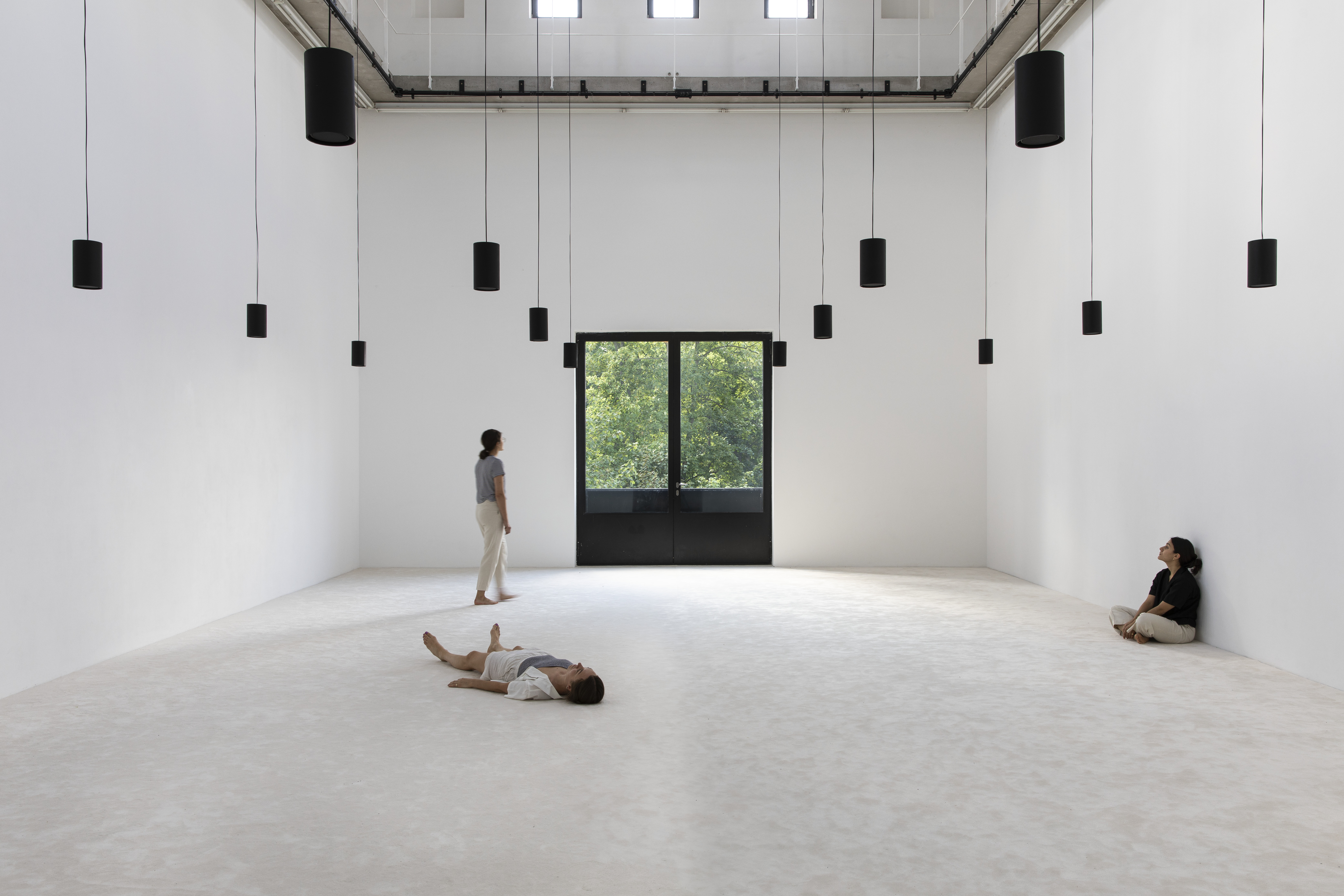

Hajra Waheed, Hum (2020), multi-channel sound installation with custom speaker castings, 36 minutes, 17 seconds. Installation view, Portikus, Frankfurt, Germany. Courtesy the artist. Photo: Diana Pfammater
Hajra Waheed: A Solo Exhibition
Review
Annette LePique
For artist Hajra Waheed, the distances between fact and fiction are not non-existent, rather the concepts of objective Truth and personal experience, naturally intermingle and weave together. One cannot exist without the other. It’s a resolutely humanistic view from an artist whose practice lives within the realm of ideas; but like fact and faction, Waheed knows that lives real and weighty are governed by the seemingly ephemeral structures of power. It’s a tension on full display in Waheed’s self-titled exhibition (Hajra Waheed: A Solo Exhibition) at the Contemporary Art Museum in Saint Louis.
Waheed’s childhood was spent within the confines of Saudi ARAMCO (short for the Arabian American Oil Company) compound located in the city of Dhahran, in Saudi Arabia’s eastern province. Dhahran is an important city within the global oil industry as Saudi Arabia’s first commercially viable oil well was discovered there in 1938. While in Waheed’s telling the compound began as a rough and ready factory town, it had transformed into a bustling, yet insular, hub of company commerce by the time her parents had settled there for her father’s job as a ARAMCO geologist. It was growing up within the ARAMCO compound, going to ARAMCO funded schools, and consuming only an ARAMCO approved view of global relations during the heights of the Gulf War, which set in motion Waheed’s lifelong desire to uncover the hidden connective tissues between imperialism and global capitalism.
While the exhibition centers the material expansiveness of her practice (the show includes works on paper with ink, paint, and her poetry) the heart of the show is the immersive sound installation: the 2020, Hum. To experience the piece, you step into a white corridor, carpeted white, blindingly white, and leave your shoes outside the space. Installation signage requests that visitors’ do not speak within the exhibition. A series of hanging black speakers further highlight the whiteness of the walls. The audio begins to echo from the speakers and deep humming begins, threads of various melodies, of different songs of freedom, merge together to form a unified whole. The silence the space requires of its visitors, the trancelike nature of the audio, and blankness of the walls, the floor, lends the installation an atmosphere of sanctity. There is something righteous, something holy in the act of coming together; of hearing and feeling that togetherness beyond the realm of the visual.
Hum is a multi-channel sound installation. Waheed originally created the piece for the Lahore Biennale 02 in Pakistan. The act of humming upsets the boundary between one’s interiority and exteriority. A low reverberation, borne in deepest most secret recesses of your diaphragm, brings to life a sound, a new note, a type of music recognized by those who can put words to your melody, recognized by those who can sing along with you. In Waheed’s Hum, protest songs by Egyptian composer Imam Mohammad Ahmad Eissa, Pakistani poets Faiz Ahmed Faiz and Habib Jalib, Sudanese singer Muhammad al-Makki Ibraheem, Rohingya songwriter Hamid Hussain, and Kurdish musician Nûdem Durak, meld together to form a landscape of sound, one that penetrates to your core. All six artists survived persecution in their home countries and so too their music survives. These are melodies that seem to take on a life of their own, it becomes difficult to tell where you begin and the humming ends.
Such an experience is a way to share language in the spaces where language is often denied. It’s in systems that deny one’s own humanity and the humanity of others in which subterranean, subaltern modes of resistance and community can bloom. “Hum” not only functions as a descriptor of the audio in the installation, as when the word is translated into Urdu, it means “we.” Hum becomes an act, a name, and a way of being; it is a way to remember and celebrate what it means to move through the world together.
In Hum II: Studies for a Sound Chamber (2023), the spiral takes shape through ink on paper. Hum II is austere, there’s an ascetic quality to the deep velvet tone of ink on the paper’s stark white. There’s a parallel to the experience of listening within Waheed’s white antechamber but movement exists differently on the page. Movement here doesn’t penetrate, rather it expands and consumes. You remain apart from the waves of ink lines that dominate the page. the curves of the spiral envelop, caress, and blanket the field of white. You stand and witness but there’s distance between you and this field of white. It is this very distance which allows for the space to think about the spiral in your own life: it’s grooves, it’s hidden connections, the patterns that govern the separations between you and the multitude of life that exists in your wake.
The deep rumblings of song, their halos of notes and the curling aural ribbons of their melodies take on the form of the spiral; it is an image that impassively yet decisively winds throughout the exhibition. A bit like a god, a bit like a fate, the spiral in Waheed’s hands becomes fact: it’s a fact that calls to mind the paper chains children hang on mantel pieces, the metal links holding shipping containers to wharf, and the echoes that shimmer outward from a protestor’s megaphone. If Waheed’s spirals could speak, they would present the cacophony of voices that make up the disarray, the beauty, the violence, and the hidden links of modern life under global carceral capitalism. In Waheed’s hands, the spiral becomes the vehicle by which our intrinsic connection to one another is crystallized.
Waheed’s video piece, Spiral (2019) functions as both a visual poem and treatise on what and how we see. Though the 7 minute video features images of a tropical canopy under evening stars, Waheed’s cyclical and dreamlike narrative applies the geometry of the spiral to this view in order to speak to humanity’s shared intimacies, complexities, and frictions within systems of oppression.
Spiral asks viewers who they are and what they are fighting and living for in our interconnected, enmeshed mass of life. In the beginning of the piece, Waheed states that “the spiral is much more than just a form.” Such a statement could veer into the realm of the esoteric or pat, but when coupled with Waheed’s images of nature, it incurs a trancelike, meditative quality. The boughs and fronds of a tree are veiled by gray shadows as Waheed traces the spiral’s mode with the lines “it expands and contracts, increase and decreases reveals even as it hides all the while offering back anew whatever it receives.” It’s these notes that could be considered a thesis for Waheed’s practice. As she traces the lineages of globalism, capital, and state sanctioned violences, these threads wind toward and away from one another. They curl, they coil, her lines of thinking both intersect and repel as do the lines of history and dislocation she traces across the globe.
The spiral is also an iris and aura, an ouroboros winding ever tighter. In the watercolor Sound Studies 1-6 (2023) fields of rain-tamed and leaden colors, ochres, hunter greens, and oranges, radiate outward. The colors pulsate both in pleasure and pain, apparatuses that see both too much and too little all at once. The series itself, these delicate apparatuses, these soft machines that gaze back, is kin to the imagery commonly found in science fiction. Waheed’s area of study, the surreality of technology, security, privacy, and violence, are comfortable bedfellows with the intricacies of sci-fi for we live in a world formed by the tenuous and tremulous spaces between fact and fiction. This space, present in both Waheed’s visual and sound work, allows for fluctuations and frictions in viewer experience. Ink and notes radiate outward to ears, and eyes, but their meaning changes and transforms through each fragile interaction. Yet, these differences in interpretation ground a shared experience: we are listening, we are seeing, we are feeling, together.
This notion of collectivity, typified through the push and pull of the spiral, lies at the heart of Waheed’s exhibition. What does it mean to dwell in these spaces, ones defined by their ambiguity, their absences, and silences? Waheed offers no easy answers to such questions as meanings can shift depending on where and how you’re looking at them. These reflections and refractions are reminders of how life under global capitalism is commonly parceled out and priced for the market. Wealth, gender, race, religion, ethnicity, and location all play a role in shaping the spaces that you see.
It is a lesson that Waheed remembers from her early teen years, when she first left the ARAMCO complex for a girl’s boarding school in the United States. Looking back, Waheed understands that journey forcefully encouraged by ARAMCO to be one of cultural and social re-assimilation. The company required the children raised on its land, the families that worked for it to have access to an idea of normalcy, in a way telling them “you can leave, what we taught you is the way of the world, what we taught you is everything. What we do here is normal. You will always come back.” But some do not look back, Waheed is one of those who left. She tells of her time at the school as her first contact with polarizing forms of “American” feminism. This political posture, formed through the privileges of race, class, and gender, accompanied numerous prescriptions from the adults who surrounded her about how she, a young woman of color, should be. Waheed however cites this time as integral in developing how she approaches her work: “from a specific subject-position that encompasses being a woman, a woman of colour with complex ties and relationships to North America, the Middle East and South Asia, born of Muslim immigrant parents.”
What experiences inform your subjectivity? Where does your gaze fall? What exactly do you want to see? If you listen and look closely, you may be able to glean the hidden curls of the spiral. With care you might be able to see the connections that link us all.
-
11.17.23
Annette LePique (she/her) is a freelance arts writer and staff editor at Sixty Inches From Center. Her writing has appeared in ArtReview, Chicago Artist Writers, Chicago Reader, Eaten Magazine, New Art Examiner, NewCity, Stillpoint Magazine, and many other publications. She is a 2023 recipient of the Rabkin Prize for art journalism.

Hajra Waheed. Photo courtesy the artist.

Hajra Waheed, Video Installation Project 1-10 (2011-2013), video, 33 minutes, 14 seconds. Installation view, Musée d’art contemporain de Montréal, Quebec, Canada. Courtesy the artist. Photo: Paul Litherland.
![Video projection in a dark room showing what seems like the shadows of narrow plant leaves.]()
Hajra Waheed, The Spiral (2019), video with narration, 7 minutes, 10 seconds. Installation view, The Power Plant, Toronto, Canada. Courtesy the artist. Photo: Toni Hafkenshield.
![Sculptural artwork hung in a grid on an isolated white wall.]()
Hajra Waheed, Our Naufrage 1-10 (2014), gouache on masonite mounted in brass and wood, 14 x 17 cm each. Installation view, 57th Venice Biennale. Courtesy the artist. Photo: Francesco Galli.

Hajra Waheed, The Spiral (2019), video with narration, 7 minutes, 10 seconds. Installation view, The Power Plant, Toronto, Canada. Courtesy the artist. Photo: Toni Hafkenshield.
Hajra Waheed, Our Naufrage 1-10 (2014), gouache on masonite mounted in brass and wood, 14 x 17 cm each. Installation view, 57th Venice Biennale. Courtesy the artist. Photo: Francesco Galli.







